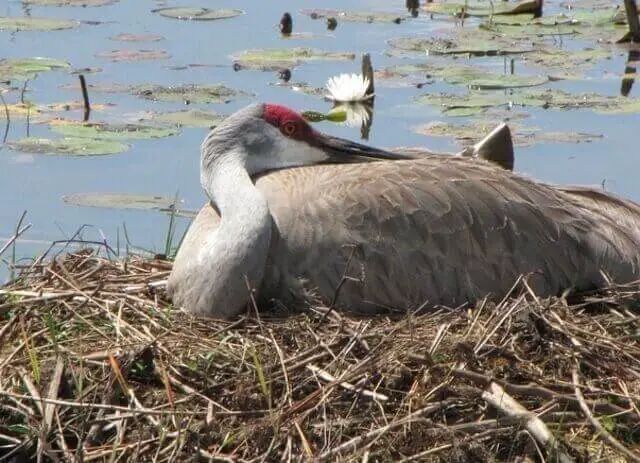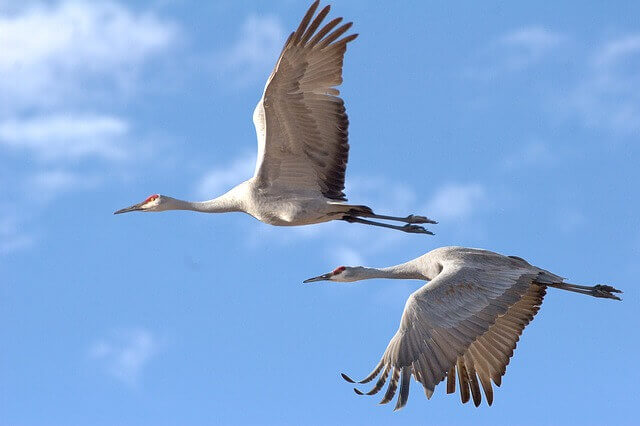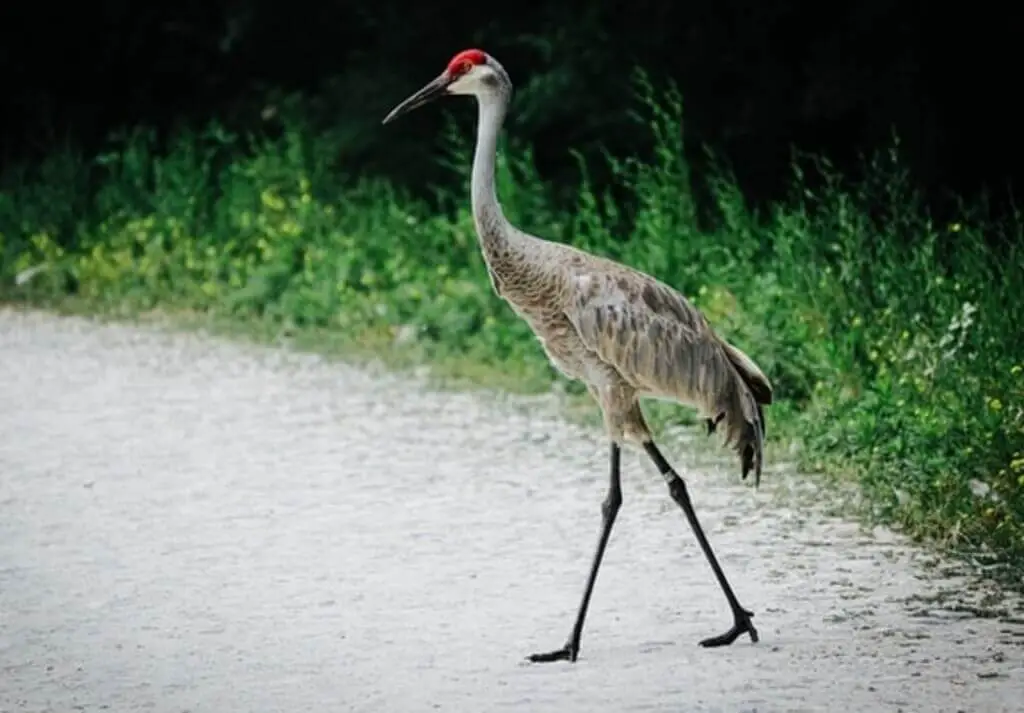Sandhill Cranes are known for their graceful dances, long migrations, and striking calls. In this blog, we’ll explore 50 fascinating facts about Sandhill Cranes, covering their traits, behaviors, and ecological roles. Whether you’re a birdwatching enthusiast or just curious, you’ll gain a deeper appreciation for these remarkable creatures. Let’s dive in and test your knowledge!
Table of Contents
General Overview
- Identification: Sandhill Cranes are a type of bird that lives in North America. They have long, dark, pointed bills and a long neck. The body feathers are mostly gray with some pale tone of brown. There is also a large red patch on the head, white throat and white patches on each cheek.
- Length: 47.0″ – 60.0″ in (120 – 152 cm).
- Weight: 7.5 – 10.8 lbs. (120 – 173 oz.).
- Wingspan: 72.0 – 78.7 in (183 – 200 cm).
- Order: Gruiformes
- Family: Gruidae
- Genus: Antigone
- Species: A. canadensis
- Scientific Name: Grus canadensis
- Lifespan: 20-30 years in the wild. 80 years in captivity.
- Range: The Sandhill Cranes are the most common crane in North America. Their range extends from southeastern Alaska to southern Canada and south through the United States to northeastern Mexico.
- Migration: They spend their winters at marshes, swamps, and other wetland habitats in Texas, Louisiana, Florida, Mexico and Central America. They have been known to migrate as far south as Panama during winter to escape the cold weather. Their migration pattern can be seen from October to March, when they fly back north again.
- Habitat: Swamps, bogs, vernal pools, prairies, wet meadows, open wetlands, freshwater marshes, grasslands, agricultural fields, and savannas.
- Diet: The sandhill crane’s diet consists of plant material (seeds, leaves & berries), small vertebrates (frogs, fish, snakes), insects (grasshoppers, beetles, ants, flies and caterpillars), crustaceans and mollusks.
- Maps: Range Map – Sightings Map
- Sounds: Songs and Calls
- Global Population: est. 650,000 individuals.
- Conservation Status: Not extinct (Listed Endangered Species).
- Breeding Period: Non-migratory birds lay their eggs between December and August, and migrating birds will lay their eggs between Feb and April.
- Incubation Length: 29-32 days.
- Clutch Size: 1-3 eggs.
- Number of Broods: 1 Brood.
- Fledgling Period: 9 to 10 months.
- Nesting Habits: Sandhill cranes nest in remote wetlands such as marshes, mudflats, shallow lakes, or bogs, and prefer to be near the dense cover of tall grasses. They will often build their nests on hummocks made by prairie dogs or other ground dwelling rodents.
- Nesting Materials: Sandhill Cranes build their nests from various materials, but they typically use cattail or tall grass to construct a large cup shaped nest that is almost 4 feet in diameter. The nest is constructed out of long stems, held together with the help of mud, which helps hold everything together. Both mates will gather material for the project.
- Mating Season: The mating season for Sandhill Cranes is November to January with the egg-laying period lasting from February to March or April (depending on the region).
- Incubation: After the nest is finished, both adults will incubate the egg for *approximately* 29-32 days, during which time they may lose up to 1/3 of their body weight. The mother feeds her chick for about 4 weeks after hatching. The young are able to fly at 9 -10.5 weeks old, but are not yet ready to leave their nest until 10 months old.
50 Fascinating Facts About Sandhill Cranes
Species Overview: Sandhill Cranes (Grus canadensis) are among the oldest living bird species, with a fossil record dating back over 2.5 million years. They are found across North America, with some populations extending into northeastern Siberia.
Physical Description: Adult Sandhill Cranes are recognized by their striking gray plumage, which can sometimes appear rusty-brown due to iron-rich mud they preen into their feathers. Their red forehead, white cheeks, and long, pointed black bill add to their distinctive look.
Subspecies Diversity: There are six recognized subspecies of Sandhill Cranes: Lesser, Canadian, Greater, Mississippi, Florida, and Cuban. These subspecies vary in size, with the Lesser Sandhill Crane being the smallest and the Greater Sandhill Crane being the largest.
Height and Weight: Standing at a height of 3 to 4 feet, Sandhill Cranes are impressive birds. Their weight ranges from 6.5 to 14 pounds, with males typically being larger than females.
Wingspan: With a wingspan stretching from 5 to 7 feet, Sandhill Cranes are powerful fliers. This extensive wingspan aids in their long migratory journeys, allowing them to glide efficiently.
Lifespan: Sandhill Cranes can live up to 20 years in the wild, though some have been known to reach up to 30 years. In captivity, their lifespan can extend even further due to the absence of predators and consistent food supply.
Mating Dance: One of the most captivating behaviors of Sandhill Cranes is their courtship dance. This elaborate display includes jumping, bowing, wing flapping, and loud trumpeting calls. These dances not only attract mates but also strengthen the bond between mated pairs.
Monogamous Bonds: Sandhill Cranes are known for their strong monogamous bonds. Once a pair bonds, they often stay together for life, working as a team to raise their young and defend their territory.
Migration Patterns: Sandhill Cranes are renowned for their lengthy migrations. Some populations travel over 3,000 miles from their breeding grounds in Canada and Alaska to their wintering sites in the southern United States and Mexico.
Stopover Sites: During migration, Sandhill Cranes use key stopover sites like Nebraska’s Platte River, where tens of thousands gather to rest and refuel. These sites are crucial for their survival during long migratory journeys.
Diet: These cranes are omnivorous, feeding on a varied diet that includes grains, seeds, berries, insects, small mammals, and aquatic plants. Their diet changes seasonally based on food availability.
Feeding Behavior: Sandhill Cranes use their long bills to probe the soil and mud for food. They are also known to forage in agricultural fields, particularly during migration and winter.
Vocalizations: Sandhill Cranes are highly vocal birds, known for their distinctive, rolling “kar-r-r-o-o-o” calls. These calls can be heard from miles away and play a vital role in communication between pairs and within flocks.
Breeding Habitat: They prefer open wetlands for breeding, often selecting marshes, bogs, and wet meadows. These habitats provide the necessary resources for nesting and raising chicks.
Nesting: Sandhill Cranes build their nests on the ground, often in shallow water to deter predators. Nests are constructed from plant material like cattails, grasses, and sedges.

Eggs and Incubation: Typically, a female lays two eggs per breeding season. Both parents share incubation duties, which last about 30 days.
Chick Development: Sandhill Crane chicks, known as colts, are precocial, meaning they are born with downy feathers and can leave the nest within 24 hours of hatching. They start foraging alongside their parents almost immediately.
Parental Care: Both parents are involved in raising the chicks, teaching them essential survival skills like foraging and avoiding predators. The family unit stays together until the next breeding season.
Fledging: Chicks fledge, or develop the ability to fly, at around 65-75 days old. However, they remain with their parents for several more months, learning crucial life skills.
Predators: Common predators of Sandhill Cranes include raccoons, foxes, coyotes, and large birds of prey. Eggs and young chicks are particularly vulnerable to predation.
Defensive Behavior: When threatened, adult Sandhill Cranes use their powerful bills and strong legs to defend themselves and their young. They can deliver strong pecks and kicks to deter predators.
Wintering Grounds: In winter, Sandhill Cranes gather in large flocks in warmer climates. Popular wintering sites include Florida, Texas, and Mexico, where they find abundant food and suitable roosting areas.
Conservation Status: While most populations of Sandhill Cranes are stable or increasing, the Mississippi and Cuban subspecies are considered endangered. Conservation efforts focus on habitat protection and restoration.
Habitat Loss: One of the biggest threats to Sandhill Cranes is habitat loss due to agriculture, development, and wetland drainage. Protecting and restoring wetland habitats is crucial for their survival.
Role in Ecosystem: Sandhill Cranes play a significant role in their ecosystem by controlling insect and rodent populations and dispersing seeds through their droppings, which helps maintain plant diversity.
Human Interaction: In some areas, Sandhill Cranes have become accustomed to human presence and can be seen foraging in agricultural fields and near human settlements.
Cultural Significance: Sandhill Cranes hold cultural significance for many Native American tribes, symbolizing longevity, wisdom, and fidelity. They often appear in tribal stories and ceremonies.
Conservation Success Stories: The conservation of Sandhill Cranes in areas like the Platte River in Nebraska is a notable success. Restoration of this vital stopover habitat has helped increase crane populations.
Research and Monitoring: Ongoing research and monitoring efforts by organizations like the International Crane Foundation help track crane populations and inform conservation strategies.
Banding and Tracking: Researchers use banding and satellite tracking to study Sandhill Crane migration patterns, behavior, and habitat use, providing valuable data for conservation efforts.
Educational Programs: Many wildlife organizations offer educational programs about Sandhill Cranes, aiming to raise awareness and promote conservation of these majestic birds.
Birdwatching: Sandhill Cranes are a favorite among birdwatchers. Popular birdwatching events, like the annual Sandhill Crane Festival in California, attract thousands of visitors.
Art and Photography: Sandhill Cranes are a popular subject in art and photography, celebrated for their graceful appearance and captivating behaviors.
Ecotourism: Ecotourism centered around Sandhill Crane migrations provides economic benefits to local communities while promoting conservation awareness.
Global Distribution: While primarily found in North America, Sandhill Cranes also breed in northeastern Siberia. Some populations are year-round residents in Florida and Cuba.
Adaptability: Sandhill Cranes are highly adaptable, able to thrive in a variety of habitats, including wetlands, grasslands, and agricultural fields.
Behavioral Ecology: Studies of Sandhill Crane behavior provide insights into their social structure, communication, and adaptation to environmental changes.
Historical Significance: Fossil records show that Sandhill Cranes have existed for millions of years, making them one of the oldest known bird species.
Roosting Habits: At night, Sandhill Cranes roost in shallow water to avoid predators. This behavior is a key survival strategy during migration and in wintering areas.
Social Structure: Outside the breeding season, Sandhill Cranes are highly social and often gather in large flocks, which can number in the thousands.

Flight Formation: During migration, Sandhill Cranes fly in V-formation or straight lines. This formation reduces wind resistance and conserves energy.
Climate Change Impact: Climate change poses a threat to Sandhill Crane habitats, affecting water levels in wetlands and altering food availability.
Role in Native Ecosystems: By feeding on a variety of plant and animal matter, Sandhill Cranes help control pest populations and maintain the health of their ecosystems.
Breeding Success: Breeding success in Sandhill Cranes is influenced by factors such as habitat quality, weather conditions, and predation rates.
Juvenile Behavior: Juvenile Sandhill Cranes, or colts, engage in playful behavior that helps them develop the skills needed for adult life.
Unique Features: Sandhill Cranes have a unique preening gland near the base of their tail that secretes oil. This oil helps waterproof their feathers.
Migration Routes: Different populations of Sandhill Cranes follow distinct migration routes, with some traveling as far as Siberia to the southern United States and Mexico.
Community Engagement: Local communities often participate in Sandhill Crane conservation efforts, such as habitat restoration projects and citizen science programs.
Importance of Wetlands: Wetlands are crucial for Sandhill Cranes, providing nesting sites, food resources, and protection from predators
Future Conservation Efforts: Ensuring the survival of Sandhill Cranes will require continued habitat protection, research, and community involvement to address ongoing and emerging threats.
Frequently Asked Questions
What are sandhill crane babies called?
The young chicks of the Sandhill Crane are called “Colts”. These baby birds live in a safe and secure environment under their mother’s wings until they are ready to take care of themselves.
Why do sandhill cranes scream?
Sandhill Cranes scream as a way to communicate with other birds, especially during mating season. In fact, the screams of male sandhill cranes is believed to be an indicator for females that he is healthy and able to provide for her and their chicks after mating has occurred.
What happens when a sandhill crane’s mate dies?
These birds are monogamous during mating season, but if one of them dies they will quickly seek out another partner to replace their lost mate. The chances of finding another partner depend on how many other male and female sandhills there are in their territory.
Can baby sandhill cranes fly?
Baby Sandhill Cranes take their first flight in about 9-10 weeks after they hatch from their eggs, but will not leave the nest until 10 months old.
What animals eat sandhill cranes?
There are a number of animals that enjoy eating sandhill cranes. Some of the predators that hunt these birds include raccoons, wolves, coyotes, foxes, hawks and eagles.
Related Articles:



